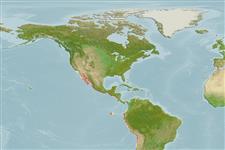Klassifizierung / Names
Namen | Synonyme | Catalog of Fishes (gen., sp.) | ITIS | CoL | WoRMS | Cloffa
Actinopterygii (Strahlenflosser) >
Perciformes (Perch-likes) >
Labrisomidae (Labrisomids)
Etymology: Labrisomus: Greek, labrax, -akos = a fish, Dicentrarchus labrax+ Greek, soma = body (Ref. 45335).
Lebensraum / Klimazone / Range
Ökologie
; seewasser riff-verbunden; tiefenbereich 0 - 5 m (Ref. 55763). Tropical, preferred ?
Eastern Pacific: Bahía Sebastián Vizcaino and the upper Gulf of California to Peru, including the Galapagos Islands.
Size / Gewicht / Alter
Maturity: Lm ? range ? - ? cm
Max length : 18.0 cm TL Männchen/unbestimmt; (Ref. 55763); common length : 10.0 cm TL Männchen/unbestimmt; (Ref. 55763)
Body small and elongate; head with a large number of sensorial pores; dorsal fin with 17 to 19 spines and 11 to 13 soft rays (XVII-XIX, 11-13); anal fin with 2 spines and 17 to 18 soft rays (II, 17-18); lateral line scales 65 to 69; body brownish, with dark blotches on the flanks and a pair of oblique, brown spots on the cheeks; dorsal, pectoral and caudal fins with scattered dark spots (Ref. 55763).
Life cycle and mating behavior
Geschlechtsreife | Fortpflanzung | Ablaichen | Eier | Fecundity | Larven
Thomson, D.A., 1987. Reef fishes of the Sea of Cortez. The rocky-shore fishes of the Gulf of California. The University of Arizona Press, Tucson. 302 p. (Ref. 5592)
IUCN Rote Liste Status (Ref. 115185)
CITES (Ref. 94142)
Not Evaluated
Bedrohung für Menschen
Harmless
Nutzung durch Menschen
Mehr Information
NamenSynonymeMetabolismusRäuberÖkotoxikologieFortpflanzungGeschlechtsreifeAblaichenFecundityEierEientwicklung
Alter/GrößeWachstumLänge-GewichtLänge-LängeLängenhäufigkeitenMorphometrieMorphologieLarvenLarven Pop.Dyn.RekrutierungDichte
ReferenzenAquakulturAquakultur ProfilZuchtlinienGenetikAllel-HäufigkeitenVererbbarkeitKrankheitenVerarbeitungMass conversion
PartnerBilderStamps, CoinsLauteCiguateraGeschwindigkeitSchwimmstilKiemenoberflächeOtolithsGehirngrößeSehfähigkeit
Tools
Zusatzinformationen
Download XML
Internet Quellen
Estimates of some properties based on models
Phylogenetic diversity index (Ref.
82805): PD
50 = 0.5005 [Uniqueness, from 0.5 = low to 2.0 = high].
Bayesian length-weight: a=0.00933 (0.00394 - 0.02210), b=3.03 (2.83 - 3.23), in cm Total Length, based on LWR estimates for this (Sub)family-body shape (Ref.
93245).
Trophic Level (Ref.
69278): 3.5 ±0.3 se; Based on size and trophs of closest relatives
Widerstandsfähigkeit (Ref.
69278): .
Verwundbarkeit (Ref.
59153): Low vulnerability (10 of 100) .
